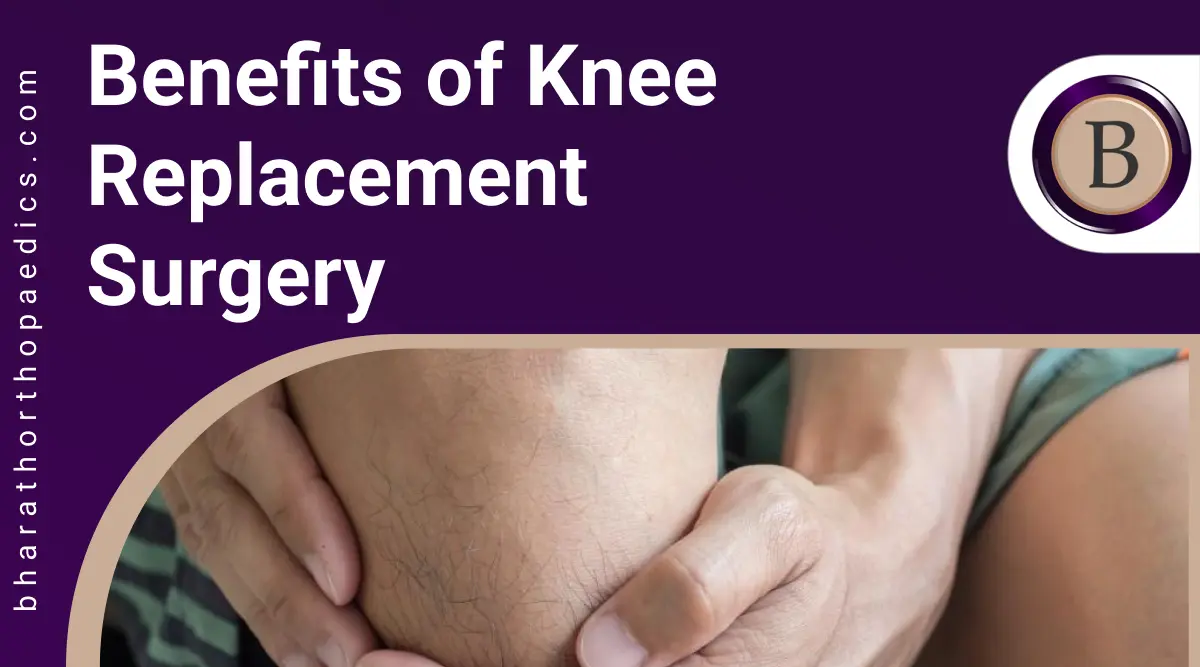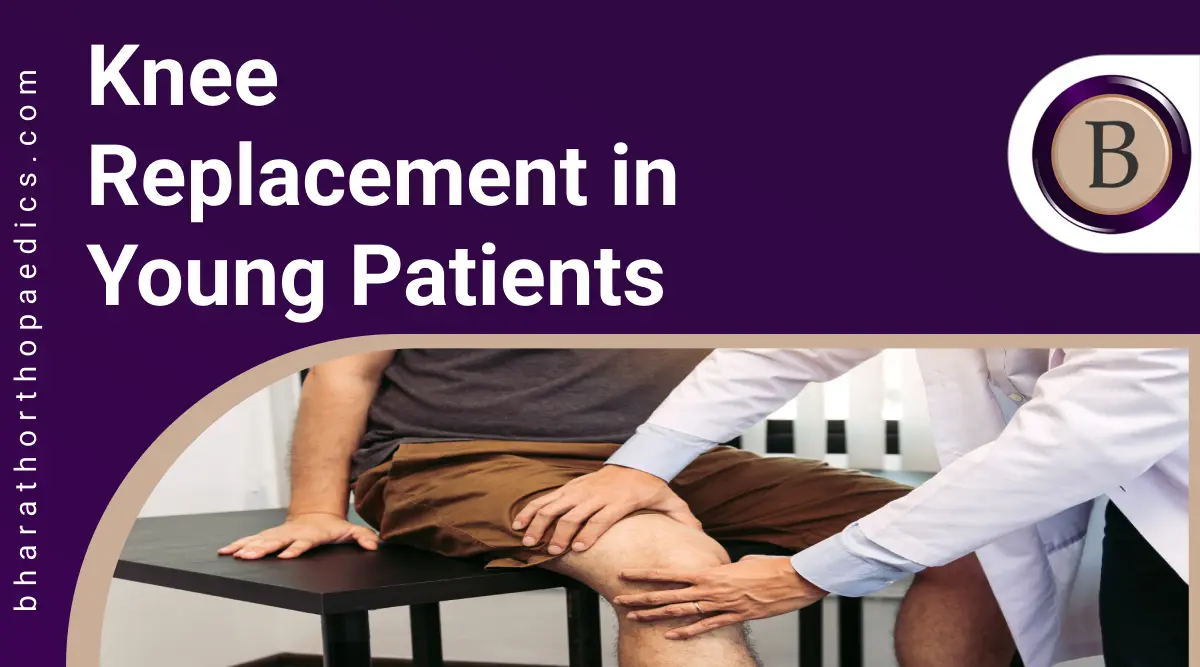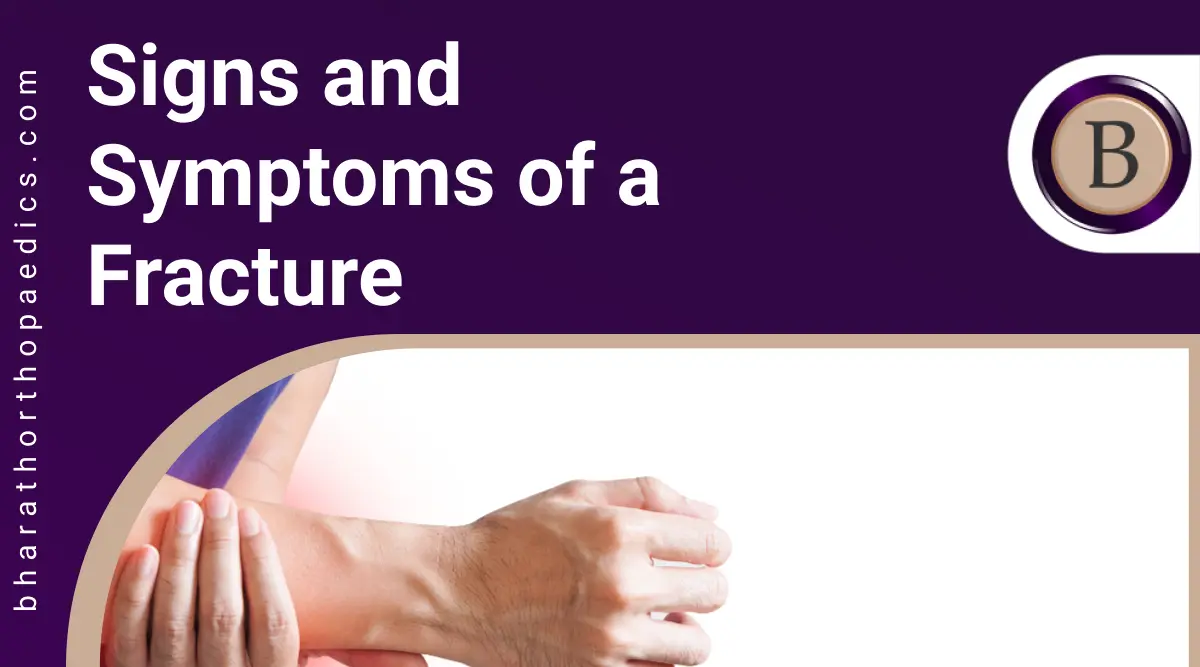Arthroscopy is a surgical procedure for diagnosing and treating all kinds of joint problems. Generally, a surgeon will insert a narrow tube that is attached to a fiber-optic video camera by making a small incision where the view inside of the joint is transmitted to a high-definition video monitor.
This helps the best arthroscopic surgeon in Chennai to repair joint disorders or damage by inserting thin surgical instruments through additional small incisions during the treatment procedure.
Any individual who is in need of this procedure may have a lot of questions before undergoing arthroscopic surgery. Is it better to consult an arthroscopic surgeon? Is arthroscopy surgery vital to treat the issue? Is it better to opt for surgery or take medications? etc. can be some of the queries raised.
At Bharath Orthopaedics, Dr. L. Bharath, an expert Best Arthroscopic Surgeon in Chennai can help you through all your questions with a detailed explanation regarding the factors to consider before pursuing an arthroscopic surgery. Besides that, before the arthroscopic surgery in Chennai, the arthroscopy surgeon will inform the patients regarding the treatment options and aid them in choosing the right one depending on their condition.
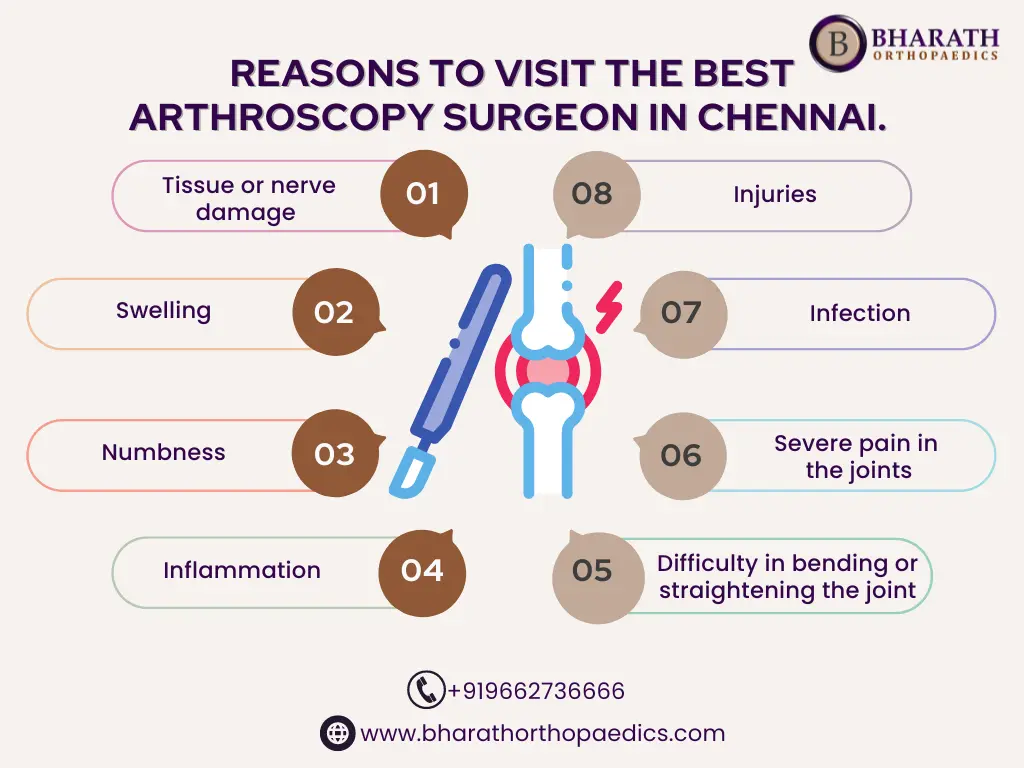
What is an Arthroscopic Surgery?
Arthroscopic surgery, or arthroscopy, is a minimally invasive procedure used to diagnose and treat joint problems. It involves inserting a small camera, the arthroscope, into the joint through a tiny incision. This camera allows surgeons to visualize the joint structures on a monitor in real-time, aiding in accurate diagnosis. Additional small incisions are made to introduce specialized instruments for performing repairs or corrections such as removing damaged tissue, repairing ligaments, or smoothing rough joint surfaces. Arthroscopic surgery offers advantages like reduced recovery time, less post-operative pain, minimal scarring, and a quicker return to normal activities compared to traditional open surgery methods.
Who is an Arthroscopic Surgeon?
An arthroscopic surgeon in Chennai, like Dr. L. Bharath, specializes in performing arthroscopic surgery, a minimally invasive technique used to diagnose and treat joint disorders. They are trained in orthopedic surgery and skilled in using an arthroscope, a small camera, to view and operate inside joints through tiny incisions. Arthroscopic surgeons, such as Dr. L. Bharath, are proficient in addressing conditions like torn ligaments, cartilage damage, and joint instability with precision instruments inserted through additional small incisions. Their expertise includes providing optimal patient care, faster recovery times, and effective management of joint-related injuries and degenerative conditions.
Best Arthroscopic Surgeon in Chennai
Dr. Bharath Loganathan
MBBS, MS (Ortho)
Best Arthroscopic Surgeon in Chennai, Dr. Bharath Loganathan is a certified orthopaedic surgeon specialized in knee and hip replacement procedures with over a decade of substantial experience and thousands of success stories to his credit. His proficiency lies in fast-track recovery joint replacement techniques, including Unicondylar knee, Total Knee & Hip Replacements, and Revision Knee & Hip Replacements, with over 10,000 surgeries performed to date.
Dr. Bharath excels in treating patients of all ages, significantly improving joint function and enhancing their quality of life. With years of professional experience, he has pioneered SMART KNEE REPLACEMENT technologies, ensuring painless procedures, rapid recovery, quick rehabilitation, and reduced infection risks post-surgery. Beyond arthroplasty, he is adept in traumatology, spine surgery, arthroscopy, pediatric orthopaedics, and deformity correction procedures.
Available Time: Mon-Sat 9:30 am to 8 pm | Sun – 10 am to 3 pm
Address: Flat-A Ground Floor , Balaji Villa, New Door No.38/1, Old Door No.9/1, Rajaratnam Street, Kilpauk, Chennai-600010
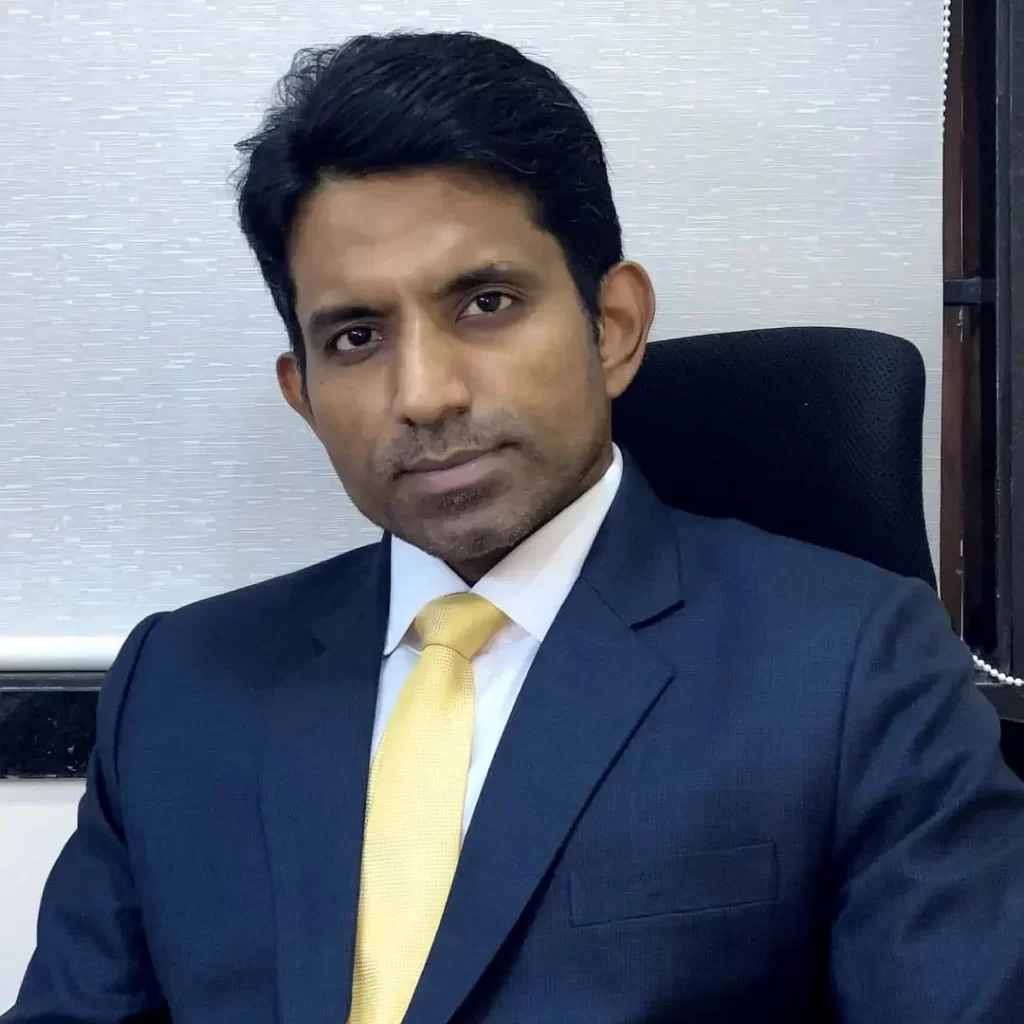
Diagnostic Procedures of Arthroscopic Surgeon
A best arthroscopic surgeon in Chennai performs diagnostic procedures using minimally invasive techniques to examine and treat joint conditions. These procedures involve inserting a small camera (arthroscope) into the joint through a small incision, allowing for detailed visualization of the joint structures such as ligaments, cartilage, and tendons. Common diagnostic arthroscopic procedures include assessing meniscus tears, ligament injuries (such as ACL tears), cartilage damage, and joint instability. This approach enables precise diagnosis, often leading to targeted treatment plans tailored to each patient’s specific needs, promoting faster recovery and improved long-term joint function.
Surgical Treatment Options for Arthroscopic Disorders
Surgical treatment options for arthroscopic disorders encompass various procedures aimed at addressing joint injuries and conditions. Common options include:
- Meniscus Repair: Restoring torn meniscus tissue to preserve joint function.
- ACL Reconstruction: Rebuilding the anterior cruciate ligament to stabilize the knee.
- Cartilage Restoration: Techniques to repair or regenerate damaged cartilage.
- Rotator Cuff Repair: Fixing tears in the shoulder’s rotator cuff tendons.
- Synovectomy: Removal of inflamed synovial tissue to alleviate pain and inflammation.
- Joint Debridement: Cleaning out damaged tissue and debris from the joint.
- Ligament Reconstruction: Repairing or replacing damaged ligaments for joint stability.
- Labral Repair: Addressing tears in the labrum of the hip or shoulder.
These procedures are minimally invasive, promoting quicker recovery and improved joint function compared to traditional open surgeries.
Treatment Procedures
Pre-Arthroscopy Procedure
The pre-arthroscopy procedure is a set of instructions adopted by Dr. L. Bharath, the best arthroscopic surgeon in Chennai to a patient before undergoing an arthroscopy surgery. The purpose of this procedure is to prepare the patient for the surgery, minimize the risk of complications and ensure the success of the surgery. The following are the steps involved in the pre-arthroscopy procedure:
- Consultation: The patient will have a pre-operative consultation with the doctor. Here Dr. L. Bharath, the best arthroscopy surgeon in Chennai discusses the procedure, the risks, and the benefits, and also answers any questions.
- Medical History: The doctor will review the patient’s medical history and perform a physical examination to determine if the patient is fit for the surgery.
- Medications: The best arthroscopic surgeon in Chennai – Dr. L. Bharath, may ask the patient to stop taking certain medications, such as blood thinners, before the surgery.
- Blood Tests: Blood tests may be done to check the patient’s overall health, including kidney and liver function, blood count, and blood clotting ability.
- Anesthesia: The patient will discuss the type of anesthesia that will be used during the surgery with the anesthesiologist.
- Fasting: The patient will be instructed to fast for at least 8 hours before the surgery.
- Preparation: The patient will be given instructions on how to prepare for the surgery, including showering with antibacterial soap, avoiding shaving, or using lotions or creams on the day of the surgery.
- Arrangements: The patient will be advised to arrange for transportation to and from the hospital and to have someone available to stay with them on the first day after the surgery.
By following these instructions, the patient can prepare for the arthroscopy surgery, minimize the risk of complications, and ensure a successful outcome.
During the Arthroscopy Procedure
During an arthroscopy procedure, the surgeon uses a small camera (arthroscope) and specialized instruments to diagnose and treat joint conditions with minimal invasiveness. Key aspects of the procedure include:
- Small Incisions: Tiny cuts made to insert the arthroscope and surgical tools, reducing trauma and recovery time.
- Visualization: High-definition images from the arthroscope guide the surgeon in assessing joint structures like ligaments, cartilage, and tendons.
- Diagnostic Assessment: Direct examination allows for accurate diagnosis of conditions such as meniscus tears, ligament injuries, and cartilage damage.
- Treatment: Surgical interventions, such as repairing tears, removing damaged tissue (debridement), or reconstructing ligaments, are performed through the arthroscope.
- Minimally Invasive: Compared to open surgery, arthroscopy minimizes tissue damage, pain, and recovery time, promoting faster healing and early rehabilitation.
- Sterile Environment: Procedures are conducted in a sterile operating room to prevent infections and ensure patient safety.
Arthroscopy enhances precision and outcomes in joint surgeries, benefiting patients with quicker recovery and improved joint function.
Recovery Procedure for Arthroscopy
Recovery after arthroscopy involves several stages to promote healing and restore joint function efficiently:
- Immediate Post-Op: Patients are monitored for anesthesia recovery and initial pain management in a recovery room.
- Pain Management: Medications are prescribed to manage discomfort and swelling.
- Physical Rest: Resting the joint to prevent strain and facilitate initial healing.
- Movement and Rehabilitation: Gradual introduction of physical therapy exercises to regain range of motion, strength, and flexibility.
- Wound Care: Keeping incisions clean and dry, following specific instructions for dressing changes.
- Activity Modification: Avoiding strenuous activities and gradually returning to normal activities per surgeon’s guidance.
- Follow-Up Visits: Scheduled appointments to monitor recovery progress, address concerns, and adjust rehabilitation as needed.
- Recovery Timeline: Typically, full recovery varies but involves returning to normal activities within a few weeks to months, depending on the extent of the procedure and individual healing response.
Following these steps supports a successful recovery after arthroscopy, promoting optimal joint function and minimizing complications.
Recovery Period
The recovery period after arthroscopy varies depending on the specific procedure and individual factors, but generally includes the following stages:
Immediate Recovery (1-2 Days):
- Rest and Monitoring: Initial rest and monitoring for any adverse reactions or complications.
- Pain and Swelling Management: Use of prescribed medications and ice packs to manage pain and swelling.
Early Recovery (1-2 Weeks):
- Gradual Activity Increase: Gentle movements and exercises to maintain range of motion and prevent stiffness.
- Physical Therapy: Beginning physical therapy to aid in strength and flexibility recovery.
Intermediate Recovery (3-6 Weeks):
- Strength Building: Continued physical therapy focusing on strengthening muscles around the joint.
- Increased Activity: Gradual return to normal activities, avoiding high-impact exercises.
Full Recovery (6 Weeks to 6 Months):
- Functional Rehabilitation: Advanced exercises to restore full joint function.
- Return to Sports/High-Impact Activities: Typically after 3-6 months, depending on the procedure and surgeon’s advice.
Each patient’s recovery timeline can vary based on the extent of the surgery, adherence to rehabilitation protocols, and individual healing rates. Regular follow-up visits with the surgeon are essential to ensure proper recovery.
Read also: Best Joint Replacement Surgeon in Chennai
Arthroscopy Consequences/Risks
Arthroscopy is a minimally invasive surgical procedure that is commonly used to diagnose and treat joint problems. Here are some of the potential consequences and risks of arthroscopy:
- Pain and swelling.
- There is a risk of infection after arthroscopy.
- Nerve or blood vessel damage.
- Adverse reaction to anesthesia.
Overall, the risks and consequences of arthroscopy vary depending on the cases of an individual. It is important to discuss all potential risks and consequences with the best arthroscopic surgeon in Chennai, Dr. L. Bharath before proceeding with the procedure.
Benefits of Arthroscopy Surgery
Arthroscopy surgery offers numerous benefits, including:
- Minimally Invasive: Small incisions lead to less tissue damage compared to open surgery.
- Reduced Pain: Less postoperative pain due to smaller incisions and minimal tissue disruption.
- Faster Recovery: Quicker return to daily activities and work due to reduced healing time.
- Lower Infection Risk: Smaller incisions decrease the likelihood of infections.
- Shorter Hospital Stay: Often performed as an outpatient procedure, reducing hospital stay duration.
- Improved Precision: High-definition imaging allows for accurate diagnosis and treatment.
- Enhanced Joint Function: Effective treatment of joint issues leads to better long-term outcomes.
- Cosmetic Advantage: Smaller scars are cosmetically preferable compared to larger, open surgery scars.
- Versatility: Suitable for diagnosing and treating various joint conditions, including meniscus tears, ligament injuries, and cartilage damage.
Conclusion
Thus, the best arthroscopic surgeon in Chennai can deal the patients who are prone to a variety of arthroscopic disorders using advanced surgical and nonsurgical methods. If you have persistent pain in the joints that prevents you from performing your day-to-day activities, visit the best arthroscopy surgeon – Dr. L. Bharath at Bharath Orthopaedics to get the right diagnosis and receive exclusive and patient-centered treatment at an affordable arthroscopic surgery cost in Chennai.
Read also Rheumatoid Arthritis Treatment in Chennai.


